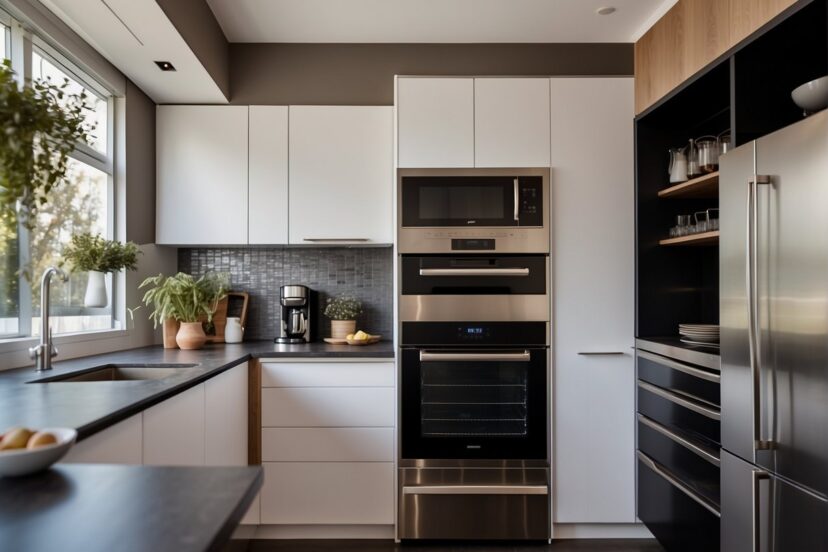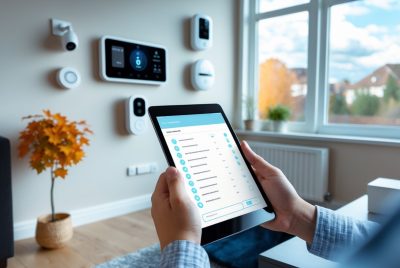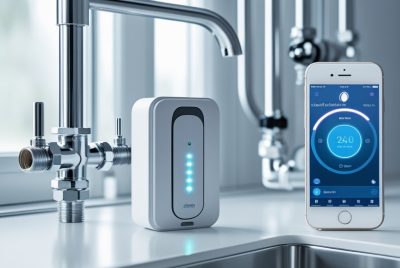Smart Appliances: Revolutionizing Home Efficiency
*We may earn a commission for purchases made using our links. Please see our disclosure to learn more.
Smart Appliances: Revolutionizing Home Efficiency
Smart appliances are reshaping the way I interact with my home, making daily tasks more convenient and energy-efficient. As I integrate these devices, from smart locks to connected ovens, I’m finding that they offer enhanced control, personalized settings, and a level of automation that was once the stuff of science fiction. Through intuitive interfaces or voice commands, I can manage multiple functions of my home with minimal effort, whether I’m on the premises or halfway around the world.

The rise of smart home technology has seen a surge in products designed to sync with apps or voice assistants, giving me the flexibility to tailor my living environment to my needs and schedule. Taking a cue from the latest trends, I’ve noticed that a majority of these devices also focus on energy efficiency, which has the dual benefit of reducing utility bills and lessening environmental impact. With smart thermostats and energy-monitoring plugs, for example, I’m able not only to control but also to monitor and analyze my energy consumption in real-time.
In embracing smart appliances, I’m joining an ever-growing community that prioritizes convenience, security, and sustainability. From smart fridges that alert me when groceries are running low to washing machines that can be activated remotely, the integration of these devices into my home is transforming it into a more connected and responsive space. Carefully selected and thoughtfully implemented, smart home devices hold the promise of making my day-to-day life more efficient and more attuned to the rhythms of the modern world.
Understanding Smart Appliances

In recent years, my interaction with home appliances has profoundly changed due to the advent of smart technology. I’ve observed that smart products are now integral components in the domain of home automation, providing unparalleled convenience and efficiency.
The Basics of Smart Home Technology
Smart home technology constitutes the core framework that allows devices within a home to connect to the internet and be remotely controlled. These devices, often termed smart home devices, can range from lights and thermostats to more complex systems like security cameras and alarms. Central to this system is a smart hub, which serves as the command center, enabling seamless communication between different devices. What distinguishes smart appliances within this setup is their ability to learn from user behaviors, adapt to our schedules, and operate autonomously to enhance our lifestyle. For instance, a smart refrigerator might not only keep my groceries cold but also track expiration dates and compile shopping lists based on consumption patterns.
- Smart Home Devices Connected to Home Automation:
- Lights
- Thermostats
- Smart Refrigerators
- Washing Machines
- Security Systems
Evolution of Smart Home Devices
The evolution of smart home devices is marked by the steady increase in their cognitive capabilities. Initially, I remember when home automation was just simple remote control for appliances. Over time, however, smart home technology has incorporated advanced features like sensors and machine learning to deliver products that can truly anticipate and cater to our needs. A modern smart home houses devices that communicate with one another to create a cohesive and intuitive ecosystem. I’ve seen smart products transition from mere remote-controlled gadgets to fully autonomous systems capable of making decisions. For example, a smart home device like a smart thermostat can now analyze my daily routine and adjust temperatures without my input, ensuring energy is used efficiently.
- Key Milestones in Smart Home Device Evolution:
- Initial remote control capabilities
- Integration of internet connectivity
- Addition of sensors for environmental monitoring
- Implementation of machine learning for predictive behaviors
- Autonomous decision-making for energy and resource optimization
In summary, my experience with smart home devices reflects a vibrant, rapidly evolving landscape where smart appliances are at the forefront of driving convenience and promoting an energy-efficient lifestyle.
Setting Up Your Smart Home

When I begin the journey of transforming my house into a smart home, my first priority is choosing devices that make my life more convenient and ensuring seamless integration with the main home assistants available today.
Choosing the Right Smart Devices
Selecting the right smart devices often begins with determining my desired outcomes: which everyday tasks do I want to simplify or automate? I make a list that might include smart lights, locks, thermostats, and perhaps a few smart plugs or cameras. For each category, I consider my own lifestyle and how a particular device will fit into it. For example:
- Smart Lights: Automating my lighting with schedules or sensor triggers.
- Smart Locks: Remotely controlling access to my home or receiving alerts about door status.
It’s essential for me to check if these devices are compatible with Matter, the new connectivity standard aimed at allowing different smart home devices to work together. I ensure that the devices I choose support either Wi-Fi network protocols because I depend on this for a stable and robust connection.
| Device Type | Matter Support | Wi-Fi Compatibility |
| Smart Lights | Yes | 2.4 GHz & 5 GHz |
| Smart Locks | In Progress | 2.4 GHz |
Smart Appliances and Integration with Home Assistants
With the smart devices chosen, I move on to integration with home assistants. I’m a user of Amazon Alexa via my Amazon Echo, but I keep in mind other popular assistants like Google Assistant and Apple’s Siri, accessed through smart speakers or smart displays. I follow these steps for a successful setup:
- I ensure the device’s mobile app is installed on my phone.
- Next, I connect the device to my Wi-Fi and ensure it’s on the same network as my smart hub.
- I search within the app for the option to add a new device and follow the prompts for installation.
- Once the device is connected, I link it with my chosen voice assistant.
For those with Amazon Echo, the Alexa app guides through pairing devices seamlessly. Google Assistant users can use the Google Home app, while Apple HomeKit is perfect for Siri integration. I consider whether I need a dedicated smart hub or if my current ecosystem supports direct device connections.
By following these steps and ensuring compatibility between devices and assistants, I create a smart home environment where convenience and control are right at my fingertips. My voice becomes the command center through my voice assistant, and with a phrase, I can adjust the thermostat, switch on the TV, or lock the doors—a truly connected experience.
Key Smart Appliance Categories

Given the rapid advancement in home automation, identifying key smart appliance categories helps me comprehend where modern technology is making life more convenient and secure. From cooking to cleaning to maintaining a comfortable climate, each category brings unique enhancements to the habitual functions of a household.
Smart Security and Monitoring
Smart security is essential for peace of mind. My front door is reinforced with a video doorbell and smart locks, which allow me to see and control who enters my home, regardless of my location. Additionally, with security cameras strategically placed, I maintain a vigilant eye over my property. For comprehensive home security, these devices often work in tandem through a centralized smart home system.
Smart Kitchen Essentials
In my kitchen, smart ovens and instant pots have transformed how I approach cooking. With the ability to control these appliances remotely, I can preheat my oven or start a slow cooker with just a few taps on my smartphone. A smart refrigerator keeps track of my groceries and suggests recipes, while my smart coffee maker ensures I wake up to a freshly brewed cup every morning.
Smart Climate Control
Managing my home’s climate is effortless with a smart thermostat. This device learns my schedule and adjusts temperatures accordingly, ensuring comfort while improving energy efficiency. Smart air purifiers play a pivotal role, too, by monitoring air quality and filtering out contaminants automatically.
Innovative Cleaning Solutions
Keeping my home tidy is less of a chore with robot vacuums like the Roomba, which autonomously navigates and cleans the floors. Paired with a smart air purifier, not only are my floors spotless, but the air is also free from dust and allergens. The evolution of these cleaning appliances has significantly contributed to maintaining a clean and healthy living environment.
Through the integration of these smart appliances, my home has become a testament to the convenience and security that modern technology offers. Each category significantly boosts the efficiency and comfort of daily routines.
Connectivity and Control of Smart Appliances

In my experience with smart appliances, they hinge on two crucial aspects: how they connect to other devices and networks, and how they can be controlled remotely or with minimal interaction. These features are central to the functionality and appeal of smart appliances.
Wireless Protocols and Standards and Smart Appliances
The foundation of smart appliance connectivity is the Wi-Fi protocol, which enables appliances to join home or office networks. This is the most common method I have observed that allows for seamless integration with other devices. Notably, Wi-Fi enabled appliances can communicate with each other and the internet, allowing for over-the-air updates and access to cloud services.
Wi-Fi’s main advantage is its ubiquity; most homes and personal devices are already set up for Wi-Fi, which makes integration straightforward. However, signal strength is a factor to consider, as robust connections are needed for optimal performance.
Remote Access and Management
Remote control of smart appliances typically occurs via a mobile app. Whether I’m at home or out, I can adjust settings, start or stop functions, and monitor the status of my appliances from my phone or tablet. With a mobile app, I’ve found that you can essentially carry control of your home with you.
Smart plugs also play a crucial role in remote management. They can be inserted into traditional outlets, giving non-smart devices some smart capabilities, like turning on and off remotely. This is especially useful for managing devices that weren’t originally designed to be ‘smart’.
I’ve also noticed that remote access not only contributes to convenience but also enhances energy efficiency by ensuring devices run only when needed. The ability to manage appliances while away can help mitigate risks and improve the safety of the home environment.
Selecting and Investing in Smart Appliances

When I guide individuals through the process of selecting and investing in smart appliances, my focus is on pairing affordability with functionality to ensure the investment is sound. Advanced customization options and easily operated interfaces are paramount.
Factors to Consider Before Purchasing
Before investing in smart appliances, it’s crucial to assess their usability and whether they align with your lifestyle requirements. I consider factors such as energy efficiency, which can offer long-term savings, and compatibility with other smart home systems. Affordability and convenience should go hand in hand; an expensive appliance should justify its price with superior features or energy savings. Here are specifics to ponder:
- Usability: Is the interface user-friendly?
- Energy Efficiency: Will this appliance save on utility bills?
- Compatibility: Does it integrate well with existing smart home ecosystems?
- Customization: Can settings be easily adjusted to suit personal preferences?
Cost vs. Convenience of Smart Appliances
Smart appliances often carry a premium over their traditional counterparts, but the convenience they offer can be worth the extra cost. For instance, a LG or GE Profile smart fridge with a Family Hub might be pricier, but being able to see inside the fridge remotely saves time and minimizes waste. I look at:
- Initial Cost: Is it within budget?
- Long-Term Savings: Are there efficiency savings that offset the upfront cost?
- Time Savings: How much time will I save with smart features like remote operation?
Product Reviews and Recommendations
Before purchasing an appliance like a Samsung French door refrigerator or stainless steel smart oven, I read consumer reports and reviews for real-world insights. Recommendations provide a snapshot of performance and long-term reliability. Some points I follow include:
- Consumer Reports: They often reveal the longevity and efficiency of appliances.
- Customer Reviews: I watch for consistent praise or complaints about specific models.
- Expert Recommendations: Proficient insights can spotlight aspects I might have overlooked.
When investing in smart appliances, I weigh the balance of cost, convenience, and customization to ensure the appliance fits both my lifestyle and my budget.
Frequently Asked Questions
In this section, I’ll address some of the most common inquiries regarding smart appliances, focusing on their functionality and advantages in the realm of home automation.
1. How do smart appliances enhance home automation?
Smart appliances connect to home automation systems, allowing for automated tasks, scheduling, and remote control. This streamlines household chores, offering convenience and improving efficiency.
2. What are the benefits of using high-tech kitchen appliances?
High-tech kitchen appliances provide greater precision in cooking, energy savings due to more efficient usage, and remote control options. They also tend to feature advanced diagnostic capabilities for easier maintenance.
3. Which smart appliance brands lead the market?
Brands such as Samsung, LG, and GE are known for their smart appliance offerings. These brands often lead the market in incorporating innovative features such as AI and advanced connectivity options.
4. How do WIFI-enabled appliances interact with home networks?
WIFI-enabled appliances connect to home networks to allow for remote operation via smartphones or voice commands. They can send alerts, receive updates, and even download new functions.
5. Can smart appliances be integrated with existing home systems?
Yes, many smart appliances can be integrated with existing home systems, especially if they share common standards like Z-Wave, Zigbee, or are compatible with platforms like Apple HomeKit, Google Home, and Amazon Alexa.




